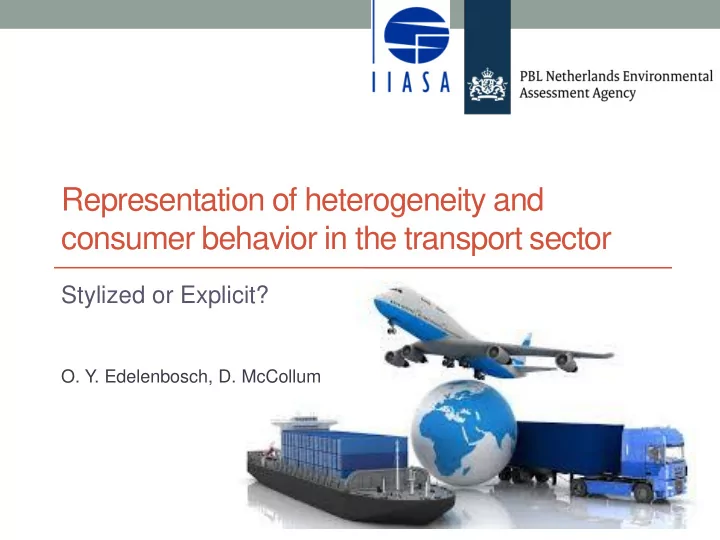

Representation of heterogeneity and consumer behavior in the transport sector Stylized or Explicit? O. Y. Edelenbosch, D. McCollum
21-04-2015| Oreane Y. Edelenbosch - BE4 Workshop Non cost barriers in consumer choice • Adoption of new vehicle technologies rely on consumer purchases • Energy efficiency research shows that consumers do not purchase energy-efficient technologies based solely on a cost-effectiveness criterion (Mundaca et al. 2010) • And that choices are heterogeneous as considerations are different for consumers Non Cost Barriers for different types of consumers are captured in the MA 3 T disutility dataset
21-04-2015| Oreane Y. Edelenbosch - BE4 Workshop Key question • Most Integrated Assessment Models (IAMs) represent investment decisions in technology as done by a homogeneous and ‘ unboundedly rational ’ end user • How to represent in our models influences on vehicle choices beyond costs and prices. • Can we use a simple model to represent this complex issue? (given scope of IAMs, data quality)
21-04-2015| Oreane Y. Edelenbosch - BE4 Workshop Outline Research 1. Implement non monetary factors (disutility costs) disaggregated over consumer 27 groups implemented in IMAGE Does adding the consumer groups lead to more heterogeneity? 2. Parameterize the multinomial equation in IMAGE vehicle choice model Can this heterogeneity be approximated or parameterized in a simpler, more stylized way?
21-04-2015| Oreane Y. Edelenbosch - BE4 Workshop IMAGE transport • Transport activity is related to population, income, mode costs, speed • Techno-economic parameter for each technology are exogenously assumed. • Technologies compete with each other based cost per passenger km • Technologies modelled are ICE, HEV, PHEV, Fuel Cell, EV Focus Research: • Vehicle choice in passenger road transport (cars)
21-04-2015| Oreane Y. Edelenbosch - BE4 Workshop Vehicle choice model 1.00 Market share 0.75 0.50 0.25 Add Disutility cost 0.00 1.0 2.0 3.0 Cost ratio = high full optimisation = 0 indifferent = low heterogeneity
21-04-2015| Oreane Y. Edelenbosch - BE4 Workshop Scenario results US - baseline 27 consumers No electric vehicle adoption Without disutility cost With disutility cost
21-04-2015| Oreane Y. Edelenbosch - BE4 Workshop Scenario results US - mitigation 27 consumers Slower phase out of oil More cars on biofuel More heterogeneity Without disutility cost With disutility cost
21-04-2015| Oreane Y. Edelenbosch - BE4 Workshop Parameterizing the MNL 27 groups 1 group 𝜇 = 100
21-04-2015| Oreane Y. Edelenbosch - BE4 Workshop Parameterizing the MNL 27 groups 1 group 𝜇 = 50
21-04-2015| Oreane Y. Edelenbosch - BE4 Workshop Parameterizing the MNL 27 groups Decreasing 𝜇 leads to more heterogeneity in choices but does not reflect the spread in attitude towards a technology 1 group 𝜇 = 10
21-04-2015| Oreane Y. Edelenbosch - BE4 Workshop Vehicle choice model in IMAGE
Differentiating in the 27 groups 1 group Resembles 27 groups better than original
21-04-2015| Oreane Y. Edelenbosch - BE4 Workshop Conclusions and ways forward: • Logit parameterization can reflect explicit representation of heterogeneity. Results improve when 𝜇 is technology specific • Current disutility cost are static which is a barrier for vehicle transition Endogenise disutility cost assumptions on refuelling stations, model availability • Subsidies for early adopters
21-04-2015| Oreane Y. Edelenbosch - BE4 Workshop Thanks for your attention. Questions?
21-04-2015| Oreane Y. Edelenbosch - BE4 Workshop MA 3 T Model disutility costs Lin, 2009. Oakland Ridge National Laboratory 100 Non cost barrier 90 • Limited EV Range “anxiety” Fuel cost Cost per pkm driven 80 (USD ¢ / pkm) 70 Vehicle cost • Refueling Station Availability 60 • Model Availability 50 40 • New Technology Risk Premium 30 20 So, this data set only 10 includes additional barriers 0 for electric vehicles Internal Combustion Fuel Cell Vehicle Electric Vehicle Engine (ICE) (FCV) (EV) Late technology Early technology adopter adopter
21-04-2015| Oreane Y. Edelenbosch - BE4 Workshop 27 Consumer groups Light-Duty Vehicle Attitude toward technology/risk Consumers/Drivers Early Majority Late Majority Early Adopter Urban Urban Urban Settlement Suburban Suburban Suburban Type Rural Rural Rural Frequent … … … … … … … … Driver Average <= structure repeated => Driver Intensity Driving Modest Driver
Differentiating in the 27 groups 1 group
Differentiating in the 27 groups 1 group
Differentiating in the 27 groups 1 group
Differentiating in the 27 groups 1 group
Differentiating in the 27 groups 1 group Does not resembles 27 groups better than original
21-04-2015| Oreane Y. Edelenbosch - BE4 Workshop Comparison model results Mitigation Mitigation No disutillity cost Disutillity cost Electric car deployment 2020-2045 2040-2050 30 – 40 yr 60 – 80 yr Phase out of fossil ICE 57 – 81 % Max % ICE Bio deployment 0 - 8.5 % Cumulative CO 2 emissions 14 - 15 GtC 17 - 21 GtC (1990-2100)
Recommend
More recommend